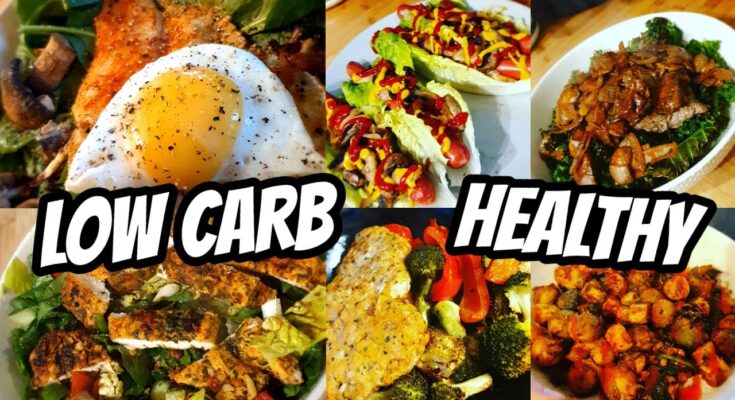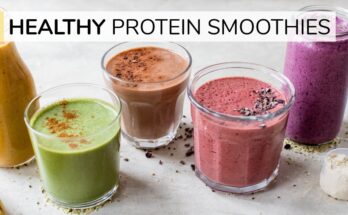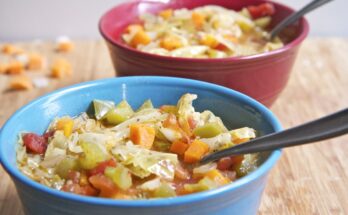Low Carb Recipes for Weight Loss: Weight loss doesn’t have to mean bland food or endless salads. One of the most effective and sustainable approaches is following low carb recipes. By reducing the amount of carbohydrates you eat and focusing more on proteins, healthy fats, and nutrient-rich vegetables, your body begins to burn fat for energy instead of relying solely on sugar from carbs. This natural process, often referred to as ketosis or fat adaptation, helps people lose weight effectively while still feeling full and satisfied.
But low carb eating isn’t just about dropping pounds. Many people report experiencing steady energy levels, better focus, reduced cravings, and even improved sleep. Unlike traditional “low-calorie” diets, which often leave you hungry and irritable, low carb recipes allow you to eat hearty meals while still trimming your waistline.
Think of your body as a car: carbs are like quick fuel, burning fast but running out quickly. Fats and proteins, on the other hand, are like premium fuel—long-lasting and efficient. When you adopt low carb recipes into your daily lifestyle, you’re teaching your body to run on a cleaner, more sustainable fuel source.
Whether you’re brand new to this way of eating or simply looking for practical recipes and a step-by-step guide, this article will walk you through everything you need—from essential ingredients to delicious meal ideas.
Understanding Low Carb Diet Basics
Before we dive into the recipes, let’s break down the fundamentals of a low carb diet.
Carbohydrates are found in foods like bread, rice, pasta, potatoes, fruits, and sugary snacks. When eaten, your body breaks them down into glucose (sugar), which becomes your main energy source. The problem? Too many carbs cause blood sugar spikes, leading to energy crashes, constant hunger, and fat storage.
A low carb diet simply reduces this intake—typically to 20–100 grams of net carbs per day depending on your goals. Net carbs are calculated by subtracting fiber (and sometimes sugar alcohols) from total carbs, since fiber doesn’t spike blood sugar.
For example:
- A cup of broccoli has 6g total carbs but 2g fiber = 4g net carbs.
- A slice of white bread may have 15g carbs and 1g fiber = 14g net carbs.
This distinction matters because not all carbs are bad—vegetables, seeds, and nuts provide fiber and nutrients without spiking blood sugar.
Common mistakes beginners make include:
- Eating too much protein, which can still turn into glucose in the body.
- Cutting out vegetables and missing out on fiber.
- Not balancing electrolytes (salt, potassium, magnesium), which can cause fatigue.
When you understand the basics of how carbs affect your body, you’ll see why low carb recipes are so powerful for weight loss.
Essential Ingredients You’ll Need for Low Carb Recipes
Stocking your kitchen with the right low carb ingredients is half the battle. If you have these items on hand, cooking delicious, weight-loss-friendly meals becomes quick and stress-free.
Proteins
Protein is the foundation of low carb eating. It keeps you full, helps build lean muscle, and prevents cravings. Great sources include:
- Chicken, turkey, and beef
- Fish and seafood (salmon, tuna, shrimp)
- Eggs (boiled, scrambled, omelets)
- Plant-based options like tofu and tempeh
Healthy Fats
Don’t fear fats—they’re essential for energy and flavor on a low carb diet. The right fats actually help you lose weight by keeping you full. Some staples are:
- Avocados and guacamole
- Olive oil and avocado oil
- Coconut oil for cooking
- Nuts (almonds, walnuts, macadamia) and seeds (chia, flax, sunflower)
Low-Carb Vegetables
These are your go-to carb replacements. They’re nutrient-rich, filling, and versatile. Examples include:
- Leafy greens (spinach, kale, lettuce)
- Cruciferous veggies (cauliflower, broccoli, cabbage)
- Zucchini (great for “zoodles”)
- Bell peppers, mushrooms, cucumbers
Flavor Boosters
To keep your recipes exciting, use herbs and spices:
- Garlic, onion, ginger
- Basil, oregano, rosemary, thyme
- Lemon or lime juice
- Cheese (parmesan, cheddar, mozzarella)
Pantry Staples
Low carb baking and cooking require a few specialty items:
- Almond flour and coconut flour (for breads and pancakes)
- Chia seeds and flaxseeds (for puddings, thickening, egg replacement)
- Unsweetened nut butters
- Stevia or monk fruit (natural sugar substitutes)
With these ingredients in your pantry, you’ll always have the foundation for a satisfying low carb meal.
Step-by-Step Guide to Preparing Low Carb Recipes
Now that your pantry is ready, let’s go step by step to ensure your low carb cooking journey is smooth and successful.
Step 1 – Plan Your Meals
Meal planning saves you from last-minute unhealthy choices. Write down your meals for the week, focusing on proteins, fats, and low carb veggies. For example:
- Breakfast: Eggs with avocado
- Lunch: Grilled chicken salad
- Dinner: Salmon with cauliflower mash
- Snack: Cheese and cucumber slices
Step 2 – Prep Ingredients Ahead of Time
Spend one or two hours chopping veggies, marinating meats, and preparing snacks. Store them in clear containers so you can grab and cook quickly.
Step 3 – Use the Right Cooking Techniques
Low carb recipes thrive with methods like:
- Grilling or baking meats for flavor without extra carbs
- Stir-frying veggies in olive oil
- Steaming vegetables to keep nutrients intact
- Using air fryers for crispy, low-oil dishes
Step 4 – Control Portions and Plate Smartly
Even on low carb, portion sizes matter. Fill half your plate with vegetables, one-quarter with protein, and one-quarter with healthy fats. This ensures balance and keeps calories in check.
Step 5 – Track Your Carb Intake Daily
Use apps like MyFitnessPal or Carb Manager to track net carbs. This helps you stay accountable and ensures you’re within your weight-loss range.
When you follow these step-by-step strategies, cooking low carb recipes becomes second nature.
10 Easy and Delicious Low Carb Recipes for Weight Loss
When you think of a diet, the first thing that comes to mind is often bland food or tiny portions. But low carb recipes flip that script—you can eat delicious, satisfying meals while still losing weight. Below, you’ll find some simple low carb recipes broken down into breakfast, lunch, dinner, and snacks/desserts that are easy to prepare, packed with nutrients, and absolutely tasty.
Breakfast Recipes
1. Egg Muffins with Spinach and Cheese
These are the ultimate grab-and-go breakfast. Beat some eggs, toss in chopped spinach, onions, cheese, and pour into muffin tins. Bake until firm, and you’ve got a week’s worth of breakfasts ready. Each muffin is packed with protein and very low in carbs.
2. Chia Seed Pudding
Mix chia seeds with unsweetened almond milk, vanilla extract, and a sugar substitute like monk fruit. Let it sit overnight in the fridge, and you’ll wake up to a creamy, pudding-like breakfast. Top with a few berries or crushed nuts for added crunch.
3. Avocado Omelet
Whip up an omelet stuffed with avocado slices, cheese, and maybe some smoked salmon. This combination of protein and healthy fats will keep you full until lunchtime without a sugar crash.
Lunch Recipes
1. Zucchini Noodles with Pesto
Swap pasta for spiralized zucchini (zoodles). Toss with homemade pesto, grilled chicken, and a sprinkle of parmesan cheese. It tastes like comfort food but keeps carbs extremely low.
2. Lettuce Wrap Burgers
Ditch the bun and wrap your burger in crisp lettuce leaves. Add cheese, tomato, onions, and avocado for a filling, finger-friendly lunch.
3. Salmon Salad
Combine canned or grilled salmon with mayo, celery, cucumber, and a squeeze of lemon. Serve it over a bed of greens or stuffed in a halved avocado. It’s refreshing and nutrient-dense.
Dinner Recipes
1. Cauliflower Rice Stir-Fry
Instead of regular rice, pulse cauliflower florets in a food processor until they resemble rice grains. Stir-fry with eggs, garlic, soy sauce (or tamari), and your favorite vegetables. Add chicken or shrimp for a protein boost.
2. Grilled Chicken with Roasted Veggies
A simple yet delicious dinner: season chicken breasts with herbs and grill until juicy. Roast a medley of low carb vegetables like zucchini, broccoli, and bell peppers in olive oil. It’s wholesome, filling, and easy to prepare in bulk.
3. Steak with Broccoli Mash
Instead of mashed potatoes, steam broccoli and blend with butter, cream, and seasoning until smooth. Pair with a perfectly grilled steak for a low carb dinner that feels like a restaurant-quality meal.
Snack & Dessert Recipes
1. Keto Fat Bombs
Made from coconut oil, almond butter, and unsweetened cocoa powder, these bite-sized snacks are perfect for fighting cravings. They’re rich, satisfying, and carb-free.
2. Cheese Crisps
Bake thin slices of cheddar or parmesan until crispy. These make a crunchy, guilt-free snack that replaces chips.
3. Coconut Energy Balls
Mix unsweetened shredded coconut, almond flour, coconut oil, and a sugar substitute into bite-sized balls. Chill in the fridge and enjoy as a sweet, low carb dessert.
Tips for Staying Consistent on a Low Carb Diet
Starting a low carb lifestyle is exciting, but staying consistent can be a challenge. Here are some practical tips to keep you on track:
- Meal Prep is Your Best Friend
Dedicate a couple of hours every weekend to batch cooking. Prepare proteins, chop vegetables, and store everything in containers. This makes weekday cooking quick and effortless. - Shop Smart
Stick to the outer aisles of the grocery store—this is where fresh meats, eggs, vegetables, and dairy are usually located. Avoid the middle aisles filled with packaged snacks and sugary foods. - Plan for Eating Out
Most restaurants offer low carb options if you know what to ask for. Swap fries for a side salad, order grilled meats, and request dressings or sauces on the side. - Watch Out for Hidden Carbs
Sauces, condiments, and even “healthy” snacks can contain sugar. Always check nutrition labels for sneaky carbs. - Stay Hydrated and Balance Electrolytes
Low carb diets can cause water loss, leading to fatigue or headaches. Drink enough water and replenish electrolytes with foods like avocado, spinach, and nuts. - Don’t Be Too Strict at First
If you’re new, start by cutting out bread, pasta, rice, and sugary snacks. Gradually reduce carb-heavy foods rather than going all-in on day one.
Consistency comes down to preparation, awareness, and flexibility. If you slip up one day, don’t give up—just get back on track at your next meal.
Common Mistakes to Avoid on Low Carb Recipes for Weight Loss
Even though low carb diets are effective, many beginners unknowingly make mistakes that slow down progress. Let’s look at the most common pitfalls:
- Eating Too Much Protein
While protein is important, too much of it can be converted into glucose by the body (a process called gluconeogenesis). Balance protein with plenty of fats and vegetables. - Neglecting Fiber
Fiber is essential for digestion and satiety. Cutting out carbs doesn’t mean cutting out vegetables—make sure to include high-fiber, low carb options like spinach, broccoli, and chia seeds. - Relying on Packaged “Keto” Snacks
The market is full of “low carb” and “keto-friendly” products, but many are highly processed and filled with artificial ingredients. Stick to whole, natural foods as much as possible. - Not Drinking Enough Water
Since low carb eating causes water loss, dehydration can easily set in. Aim for at least 8 glasses a day, and add electrolytes if you feel sluggish. - Being Afraid of Fats
If you’re still stuck in the low-fat diet mindset, you may under-eat healthy fats. Remember, fats are your new fuel source—embrace avocados, olive oil, nuts, and fatty fish.
Avoiding these mistakes will not only speed up weight loss but also make your journey healthier and more sustainable.
Benefits of Following Low Carb Recipes for Weight Loss
When you commit to eating low carb, the benefits go far beyond just fitting into smaller jeans. This lifestyle change improves your overall health, mood, and energy levels in ways you may not expect. Let’s break down the most important benefits:
1. Faster Fat Loss
Low carb diets push your body to burn fat instead of glucose for fuel. This is why so many people notice visible results within just a few weeks. When insulin (the fat-storage hormone) stays low, your body becomes more efficient at tapping into stored fat for energy.
2. Stable Energy Levels
Do you ever feel that mid-afternoon crash after a carb-heavy lunch? That happens because blood sugar spikes and then plummets. With low carb meals, you avoid these swings. Instead, energy stays steady throughout the day—making it easier to focus and stay productive.
3. Reduced Sugar and Junk Food Cravings
Carbs, especially refined ones, act like fuel for cravings. Once you reduce them, you’ll notice sugar doesn’t call your name as loudly. Many people report completely losing their sweet tooth after a few weeks of consistent low carb eating.
4. Improved Mental Clarity
When your brain runs on ketones (produced when fat is burned for energy), many people describe feeling sharper, more focused, and less foggy. This is why low carb diets are sometimes called “brain fuel.”
5. Better Blood Sugar and Insulin Control
If you struggle with prediabetes, insulin resistance, or type 2 diabetes, a low carb lifestyle can help stabilize blood sugar levels. Studies show many people are able to reduce or even eliminate their need for medication under medical supervision.
6. Appetite Control
Because protein and fats are more filling than carbs, you’ll naturally eat less without feeling deprived. This makes sticking to a low carb diet easier than constantly counting calories.
Overall, the benefits of low carb recipes are long-lasting, sustainable, and life-changing. It’s not just about losing weight—it’s about gaining control of your health and your future.
Sample 7-Day Low Carb Meal Plan
To make things practical, here’s a simple 7-day low carb meal plan you can follow. Each day balances proteins, fats, and low carb vegetables, keeping meals tasty and satisfying.
Day 1
- Breakfast: Scrambled eggs with spinach and avocado
- Lunch: Grilled chicken Caesar salad (without croutons)
- Dinner: Baked salmon with asparagus and butter sauce
- Snack: Almonds and cheese cubes
Day 2
- Breakfast: Chia pudding with coconut milk and berries
- Lunch: Lettuce wrap burger with avocado and tomato
- Dinner: Zucchini noodles with pesto and grilled shrimp
- Snack: Celery sticks with almond butter
Day 3
- Breakfast: Omelet with mushrooms, cheese, and peppers
- Lunch: Tuna salad with cucumber slices
- Dinner: Grilled steak with broccoli mash
- Snack: Cheese crisps
Day 4
- Breakfast: Boiled eggs with guacamole
- Lunch: Chicken stir-fry with cauliflower rice
- Dinner: Grilled salmon with roasted zucchini and peppers
- Snack: Keto fat bombs
Day 5
- Breakfast: Greek yogurt (unsweetened) with flaxseeds
- Lunch: Egg salad served in lettuce wraps
- Dinner: Roast chicken thighs with garlic butter green beans
- Snack: Handful of walnuts
Day 6
- Breakfast: Avocado and smoked salmon plate
- Lunch: Shrimp and spinach salad with olive oil dressing
- Dinner: Baked cod with lemon and steamed broccoli
- Snack: Coconut energy balls
Day 7
- Breakfast: Vegetable frittata with cheese
- Lunch: Turkey lettuce wraps with mayo and pickles
- Dinner: Pork chops with cauliflower mash and sautéed mushrooms
- Snack: Cucumber slices with cream cheese
This plan is just an example. The beauty of low carb eating is that it’s flexible—you can mix and match meals based on your preferences while staying within your carb limit.
FAQs about Low Carb Recipes for Weight Loss
1. Can I lose weight fast on low carb?
Yes, many people notice quick results in the first two weeks due to water loss and fat burning. However, long-term success depends on consistency.
2. How many carbs should I eat daily?
It depends on your goal. For weight loss, most people do well with 20–50 grams of net carbs per day.
3. What if I get cravings?
Stay hydrated, eat enough protein and healthy fats, and keep low carb snacks like nuts or cheese on hand to fight cravings.
4. Can vegetarians follow a low carb diet?
Absolutely. Focus on eggs, dairy, tofu, tempeh, nuts, seeds, and plenty of low carb vegetables.
5. How long should I follow low carb?
Low carb can be a lifelong lifestyle, not just a short-term diet. As long as it’s balanced and nutritious, you can follow it indefinitely.
Conclusion
Low carb recipes for weight loss are more than just meals—they’re a pathway to better health, sharper focus, and sustainable fat loss. By stocking your kitchen with the right ingredients, planning ahead, and avoiding common mistakes, you’ll find this lifestyle both enjoyable and effective.
Remember, the key to success is consistency, not perfection. Start small, experiment with new recipes, and celebrate your progress. Weight loss doesn’t have to be boring or restrictive—it can be full of flavor, variety, and satisfaction.
If you’re ready to take control of your health, begin today with one of the recipes or the 7-day plan above. The results will speak for themselves.



